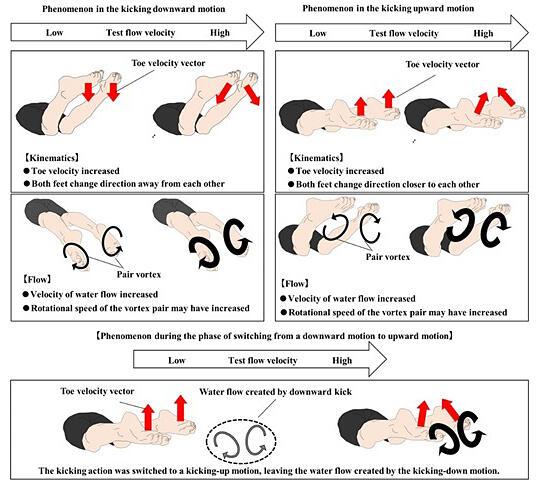A research group led by Assistant Professor Takaaki Tsunokawa of the Institute of Health and Sport Sciences at the University of Tsukuba and Assistant Professor Hirofumi Shimojo of the Department of Health and Sports of the Faculty of Health Sciences at Niigata University of Health and Welfare reported their findings that swimmers performing underwater dolphin kicks may make better use of water flow as velocity increases. Using particle image velocimetry, which visualizes flow, they determined how the water flow changed when the swimmers changed their swimming velocity during underwater swimming using dolphin kicks in an experimental circulating water flume (swimming machine). The findings of this study provide instructors teaching swimming with a scientific basis and are expected to accelerate research on water flow. The results were published in the February 24 issue of the Journal of Biomechanics, an international academic journal.

Provided by the University of Tsukuba
The dolphin kick is a technique where both legs are moved up and down together for propulsion, like a dolphin, and is used to gain propulsion after a start or turn in swimming competitions. Previous studies have reported the importance of faster leg movement to increase the swimming velocity in underwater dolphin kicks. However, the specific underlying mechanism remained unclear.
In this study, the research group investigated swimmer's movement and water flow when they changed their velocity using underwater dolphin kicks in an experimental circulating water flume (swimming machine). A motion capture system capable of analyzing three-dimensional human movements was used for motion analysis. The particle image velocimetry (PIV) method, which is commonly used in the field of fluid dynamics, was used to analyze the water flow. This method can determine the velocity and direction of fluid flow by irradiating particles mixed in the fluid with a laser. The results showed that the leg movement speed increased with an increase in the swimming velocity. Furthermore, the left and right leg movements changed in the direction of moving away from each other during the down-kick and in the direction of moving closer to each other during the up-kick.
The results demonstrated the possibility that the change in motion generates a strong vortex during the kick, which may contribute to the increased propulsion. Moreover, at the transition point from the down-kick to the up-kick, the phenomenon of reusing the water flow generated during the down-kick motion (flow recapturing) was observed. This phenomenon became more pronounced as the swimming velocity increased. Moving forward, the group plans to analyze the kicking motion, stroke motion, and vortex structure generated during swimming, for proposing training methods based on scientific evidence.
Tsunokawa said, "It was still difficult to apply the PIV analysis to the swimming movements, and the process of trial and error was repeated to optimize the experimental settings and analysis before the data were obtained successfully. I would like to clarify the three-dimensional flow and analyze other swimming methods in future studies to obtain clues that will help people swim faster."
Journal Information
Publication: Journal of Biomechanics
Title: Impact of variations in swimming velocity on wake flow dynamics in human underwater undulatory swimming
DOI: 10.1016/j.jbiomech.2024.112020
This article has been translated by JST with permission from The Science News Ltd. (https://sci-news.co.jp/). Unauthorized reproduction of the article and photographs is prohibited.




